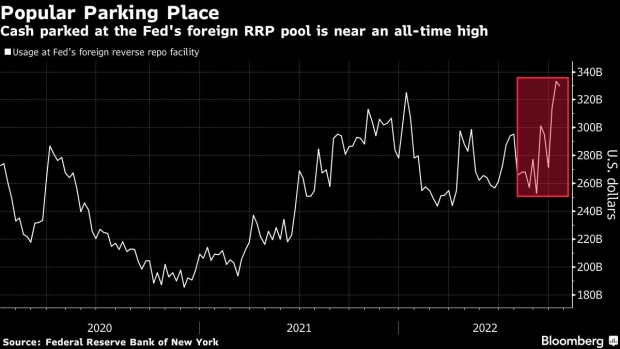Oct 21, 2022
Yen Intervention Sparks Speculation Over Japan’s Funding Moves
, Bloomberg News

(Bloomberg) -- Japan’s second intervention in a month has Wall Street once again wondering how authorities funded the dollar sales and whether that may fuel more volatility in the Treasury market.
There’s speculation that Japan’s Ministry of Finance sold securities to fund the move as the authorities did in September. Until two weeks ago, foreign central banks had been shedding holdings of US Treasuries, which suggested institutions were selling bonds to stockpile cash. There’s also the possibility the Bank of Japan drained ready funds parked at the Federal Resrve’s foreign reverse repurchase agreement facility.
Read more: Yen Surges as Japan Intervenes in Market Again to Prop It Up
“The worry is that even if the BOJ has cash for intervention now, the rate at which they are intervening will require them to sell more Treasuries for future interventions,” said TD Securities strategist Gennadiy Goldberg. “That’s really what’s driving the fear.”
Treasuries cheapened in early trading Friday, with yields soaring across the long-end and spreads steepening, as traders braced for potential Japanese intervention as the yen extended past 150.
The Ministry of Finance disclosed last month that it spent 2.84 trillion yen ($19.7 billion) in September to slow the yen’s slide in its first intervention to support the currency since 1998. Some analysts had estimated the intervention at up to 3.6 trillion yen.
Wall Street strategists initially assumed Japan removed cash from the Fed. After all, the island nation has historically been the largest user of the foreign reverse repo pool, with an estimated more than $110 billion of cash parked there, data show. Instead, the Ministry of Finance’s foreign reserves for September showed securities were worth $985 billion from $1.037 trillion the prior month, while deposits were little changed, an indication Japan sold holdings to finance its intervention.
More recently, though, foreign central banks replenished their Treasury holdings at the New York Fed for the second straight week, with the total rising $6 billion through the week ended Oct. 19 after rising by $11 billion the prior week. By comparison, official holdings of Treasuries fell by $82 billion in the six weeks ending Oct. 5.
Meanwhile, foreign central banks stashed $330 billion at the Fed’s reverse repurchase agreement facility, according to data for the period through Oct. 19, down from a record $333 billion a week earlier. That’s still $55 billion above the year-to-date average.
Data next week on Treasury holdings and cash held at the Fed’s foreign repo facility may provide more insight into fund flows and source of funding that immediately preceded the intervention.
The Fed’s creation of a reverse repo facility that’s accessible by foreign central banks means that international monetary authorities such as the Bank of Japan can keep a big chunk of their cash there earning interest instead of in Treasury bills and other securities. And when they need to do something with those dollars, they can just withdraw funds from the facility without ruffling markets.
“The big question is how much have they liquidated,” Goldberg said. “The MOF balance sheet suggests about $52 billion of selling of securities during the month of September, but the question is how much has already been sold.”
©2022 Bloomberg L.P.





